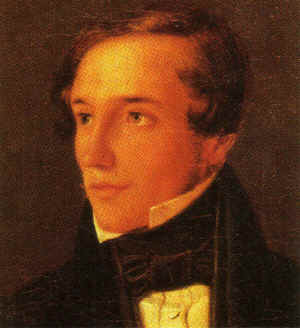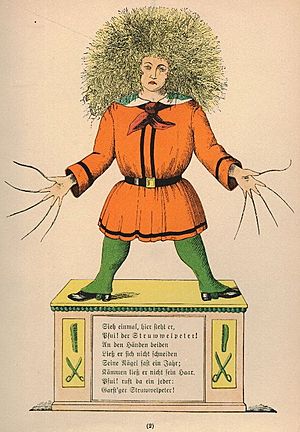Heinrich Hoffmann (author) facts for kids
Quick facts for kids
Heinrich Hoffman
|
|
|---|---|
 |
|
| Born | Heinrich Hoffmann 13 June 1809 Frankfurt, Germany |
| Died | 20 September 1894 (aged 85) |
Heinrich Hoffmann (born June 13, 1809 – died September 20, 1894) was a German doctor who specialized in mental health. He was also a talented writer. He is most famous for his book Der Struwwelpeter. This illustrated book shows funny stories about children who misbehave.
Contents
Growing Up and Learning
Heinrich Hoffmann was born in Frankfurt on Main, Germany. His father, Philipp Hoffmann, was an architect. He helped build the city's streets and waterways. Heinrich's mother passed away when he was a baby. His father later married his mother's sister, Antoinette. She became a loving mother to young Heinrich.
At first, Heinrich found school a bit hard. He was easily distracted and sometimes lazy. But he soon learned to work hard and became a good student. He studied medicine at the University of Heidelberg. He enjoyed being social and made many friends there.
His medical studies were slow because of all the fun he was having. So, he moved to Halle to focus more. There, he studied under Professor Peter Krukenberg. Heinrich even helped during a cholera outbreak in Halle. After getting his medical degree, he planned to study surgery in Paris. But he had to return home early because his father became ill.
His Family Life
Heinrich Hoffmann married Therese Donner. They had three children together. Two of their children and his wife lived longer than he did. Heinrich loved to draw funny pictures for his children. He also drew them for his wife. The famous mathematician Karl Hessenberg was his great-grandson.
Doctor and Mental Health Expert
Hoffmann worked at a clinic for people who couldn't afford medical care. He also had his own private doctor's office. He taught about the human body at the Senckenberg Foundation. These jobs did not pay very well.
In 1851, a friend who was a doctor at the Frankfurt mental hospital retired. Heinrich was eager to take the job. Even though he wasn't an expert in psychiatry (mental health care) yet, he quickly learned. He wrote important papers about mental health. Hoffmann wanted to be a kind and caring doctor. He tried to bring happiness to his patients.
He found that many patients with serious mental health issues got better. They were able to leave the hospital and stay well for years. Heinrich was always a careful thinker. He wondered if his treatments truly helped them. From 1851 onwards, he worked hard for a new hospital. He wanted a modern building with gardens. He succeeded, and a new clinic was built.
His Life as a Writer
Before 1845, Hoffmann had already published poems and a funny play. Then, a friend who was a publisher convinced him to print a book. It was a collection of illustrated children's poems. Heinrich had made them as a Christmas gift for his son.
This book later became known as Struwwelpeter. It was named after one of its main characters. The book became very popular with people. It had to be printed again and again. Many translations into other languages followed. People at the time did not think Struwwelpeter was too harsh. The original title was "Funny stories and droll pictures." This shows that Heinrich wanted to entertain children.
After Struwwelpeter was so successful, Hoffmann wrote other children's books. Only one of them, König Nussknacker und der arme Reinhold, became popular. He also kept writing funny poems and satires for adults. His satires showed that he didn't like extreme ideas. He disliked strong religious or political views. Today, he is mostly remembered for Struwwelpeter.
Hoffmann believed in liberal ideas. He supported having a king with a constitution. He took part in the Vorparlament, a meeting before a big parliament. He also joined the Freemasons, a social group. But he later left them because they would not allow Jewish people to join.
Helping the Community
Heinrich Hoffmann was a well-known person in his hometown. He was active in many public groups that were not about politics. He helped manage the Städelsches Kunstinstitut (Städel Institute of Art). He also worked with the Mozart Foundation. This foundation helped musicians like Max Bruch.
Images for kids
See also
 In Spanish: Heinrich Hoffmann (escritor) para niños
In Spanish: Heinrich Hoffmann (escritor) para niños



